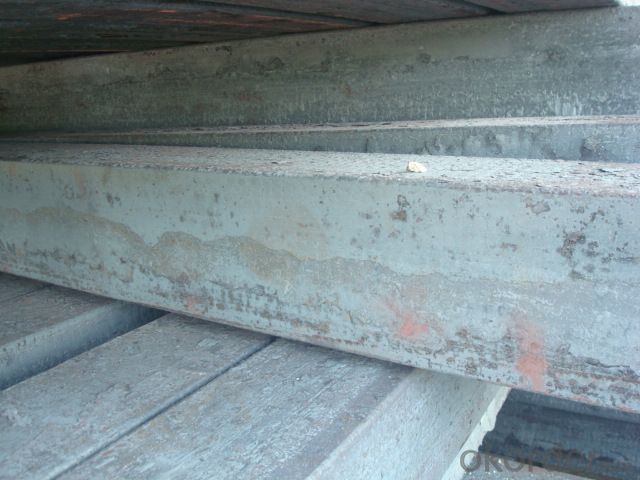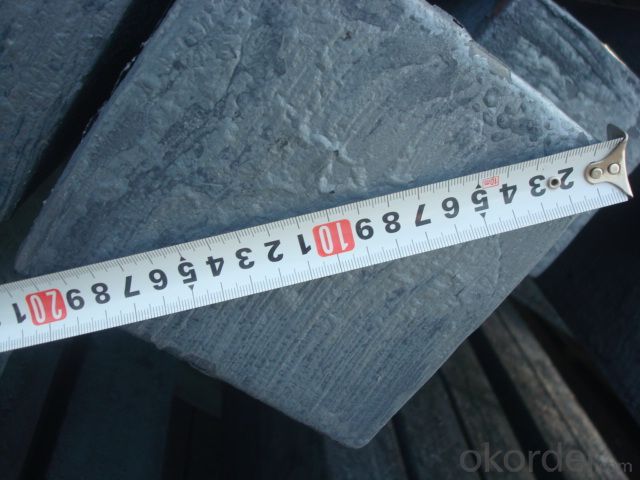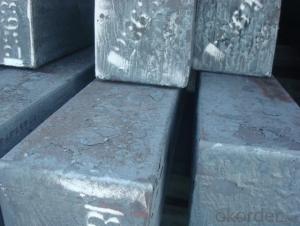Continue Casting Steel Billet Made by Blast Furnace
- Loading Port:
- Tianjin
- Payment Terms:
- TT OR LC
- Min Order Qty:
- 1000 m.t.
- Supply Capability:
- 100000 m.t./month
OKorder Service Pledge
OKorder Financial Service
You Might Also Like
Continue Casting Steel Billet Made by Blast Furnace
1.Structure of Continue Casting Steel Billet Made by Blast Furnace
Continue Casting Steel Bloom by Blast Furnace is the raw material of all kinds of steel mill. Billet section of square, round, flat, rectangular and abnormity, etc Several, mainly related to shape of rolled products. Simple rolled section steel, choose cross section of square billet or rectangular billet. rolling The sector products such as flat steel, Angle steel, select the rectangular billet or slab. Had better profiled billet when production beams, channels, and in rolling process Lines and improve the yield. The raw material of round billet is the production of seamless tube.
2.Main Features of Continue Casting Steel Billet Made by Blast Furnace
Continue Casting Steel Bloom by Blast Furnace section size should meet the requirements of rolling deformation and finished product quality, but also roll strength and biting condition of restrictions. General steel Billet section height H. And the roll diameter D The ratio of the ( namely H/D) Should be less than or equal to zero 0.5 . Length of steel billet by finishing temperature, Rolling time and the length of the product Or times ruler. When heated too long accident prone to bump the furnace wall of steel, too short, furnace bottom utilization rate is not high, influence the heating furnace production. For the production Choose a variety of steel and steel billet, should consider the affinities of billet, as far as possible in order to improve the productivity of the roughing mill, simplify the stock management of workshop.
3. Continue Casting Steel Billet Made by Blast Furnace Images


4. Continue Casting Steel Billet Made by Blast Furnace Specification
Continue Casting Steel Bloom by Blast Furnace rolled steel, after processing can be used for mechanical parts, forging parts, processing all kinds of steel, steel Q345B channel steel, wire rod is the role of the billet. Steel billet is used in the production of semi-finished products, generally cannot be used directly for the society. Steel billets and steel are strictly divided into standard, cannot decide to whether the business enterprise of the final product, and according to unified standards to perform the whole society. Typically, billet and the steel is relatively easy to distinguish, but for some steel billet, and have the same specification and same steel purposes (such as rolling tube billet), whether can be used for other industries, whether through steel processing process, whether through a finished product rolling mill processing to distinguish
Mainly from the shape is divided into two kinds:Slab: cross section width and height of the ratio of the larger, mainly used for rolling plate.Billet: equal cross section width and height, or a huge difference, mainly used for rolling steel, wire rod.Material part of the standard:Range of thickness: 150-240 - mm + / - 5 mmThe width of the range: 880-1530 - mm + / - 20 mmLength: 3700-10000 - mm + / - 500 - mmCross-sectional size: 64 * 64;82 * 82;98 * 98;124 * 124;120 * 150;152 * 164;152 * 170 mm
5.FAQ of Continue Casting Steel Billet Made by Blast Furnace
We have organized several common questions for our clients,may help you sincerely:
①How we can recoginize the blast furnace and the efa quality?
If you see the surface only, not very easy to recognize, it is better you buy from CNBM and we have to keep the contract as we sign, it is more relieable.
②Could we get the original MTC from the steel mill?
Yes, you can.
③If we found any quality problem, how long you can settel that for us?
about 7-30days with SGS report.
- Q:How are steel billets used in the production of automotive parts?
- Steel billets are commonly used in the production of automotive parts as they serve as the raw material for forging, rolling, or extruding processes. These billets are heated and shaped into various forms such as rods, bars, or sheets to create components like engine parts, suspension systems, and body frames. The high strength and durability of steel make it an ideal choice for manufacturing automotive parts, ensuring safety and performance in vehicles.
- Q:How are steel billets used in the production of automotive exhaust systems?
- Steel billets are an essential component in the production of automotive exhaust systems. These billets, which are solid blocks of steel, serve as the raw material for various parts and components of the exhaust system. The first step in using steel billets is to heat them in a furnace to a specific temperature in order to soften the steel and make it malleable. Once heated, the billets are then shaped and formed into different parts of the exhaust system, such as pipes, mufflers, and catalytic converters. This shaping process can be done through hot rolling, cold rolling, or extrusion, depending on the desired shape and properties of the component. After shaping, the steel billets are further processed to enhance their strength and durability. This can involve heat treatment processes like quenching and tempering, which improve the steel's hardness, toughness, and resistance to corrosion. These treatments ensure that the exhaust system components can withstand the harsh conditions they will be exposed to, such as high temperatures and corrosive gases. Once the steel billets have been shaped and treated, they are then assembled and welded together to form the final exhaust system. This involves joining the various components, such as pipes and mufflers, through welding techniques like arc welding or laser welding. These welding processes ensure that the components are securely connected, preventing any leaks or failures in the exhaust system. Overall, steel billets play a crucial role in the production of automotive exhaust systems by providing the necessary raw material for shaping and forming the various components. Their strength, durability, and resistance to high temperatures and corrosion make them an ideal choice for manufacturing exhaust systems that can withstand the demanding conditions of automotive use.
- Q:How do steel billets contribute to the manufacturing of aerospace components?
- Steel billets play a crucial role in the manufacturing of aerospace components. These billets are semi-finished products that are used as a starting material in the fabrication of various aerospace parts. One of the primary ways steel billets contribute to the manufacturing of aerospace components is through their versatility. Steel is known for its exceptional strength, durability, and resistance to corrosion, making it an ideal material for aerospace applications. Billets made from high-quality steel provide the necessary foundation for the production of components that can withstand the extreme conditions experienced during aerospace operations. Steel billets are often used in the production of critical aerospace parts such as engine components, landing gear, structural frames, and fasteners. The billets are first heated and then subjected to various forming and machining processes. These processes, such as forging, rolling, and extrusion, help shape the steel billets into the desired components, ensuring they meet the stringent requirements for strength, precision, and weight reduction demanded by the aerospace industry. Moreover, steel billets offer excellent design flexibility. They can be easily machined and shaped into complex geometries, allowing manufacturers to create intricate aerospace components with precise tolerances. This flexibility enables the production of lightweight yet strong parts, contributing to the overall weight reduction of aircraft and enhancing fuel efficiency. Furthermore, steel billets offer superior metallurgical properties. Through proper heat treatment and alloying techniques, the mechanical properties of the steel can be tailored to meet specific aerospace requirements. This allows manufacturers to achieve the desired balance between strength, stiffness, and toughness in the final components, ensuring they can withstand the high-stress environments encountered in aerospace applications. In conclusion, steel billets are an indispensable part of the manufacturing process for aerospace components. Their versatility, strength, design flexibility, and metallurgical properties make them an ideal starting material for the production of critical parts in the aerospace industry. By utilizing steel billets, manufacturers can ensure the production of high-quality, reliable, and durable components that meet the rigorous demands of the aerospace sector.
- Q:How is the demand for steel billets projected to change in the future?
- The demand for steel billets is expected to increase in the future due to the growing infrastructure development, urbanization, and industrialization across various regions. Additionally, the automotive and manufacturing sectors are anticipated to drive the demand for steel billets as they continue to expand. Overall, the future outlook for the demand of steel billets is positive and is expected to witness a steady rise.
- Q:How are steel billets used in the manufacturing of power generation equipment?
- Steel billets are an essential raw material in the manufacturing of power generation equipment. These billets are large, rectangular or square-shaped semi-finished steel products that are cast from molten steel and then hot rolled or forged into their final shape. In the context of power generation equipment, steel billets are primarily used in the construction of turbine components, such as turbine blades and rotors, as well as in the fabrication of generator casings and other structural parts. The high strength and durability of steel make it an ideal material for these critical components, as they need to withstand high temperatures, pressure, and rotational forces. The process begins with the selection of an appropriate grade of steel billet, which depends on the specific requirements of the power generation equipment. The billets are then heated to a suitable temperature and forged or hot rolled to shape them into the desired form. This process involves precise machining, cutting, and shaping techniques to achieve the required dimensions and surface finish. Once the turbine components and other parts are formed from the steel billets, they undergo further treatments such as heat treatment, surface coating, and machining to enhance their mechanical properties and ensure their compatibility with the power generation system. The final products are then assembled into the power generation equipment, which may include gas turbines, steam turbines, wind turbine components, or generator sets. Steel billets play a crucial role in the manufacturing of power generation equipment by providing the necessary strength, durability, and performance required for efficient and reliable operation. The quality and precision in the production of steel billets directly impact the overall performance and longevity of the power generation equipment, making them a vital component in the industry.
- Q:How do steel billets contribute to the energy industry?
- The energy industry heavily relies on steel billets, as they serve as the primary raw material for manufacturing various energy-related equipment and infrastructure. Steel billets, which are semi-finished steel products, find extensive use in the construction of power plants, oil and gas pipelines, wind turbines, and other energy infrastructure projects. A crucial application of steel billets in the energy industry lies in the production of power plant components. Boilers, turbines, and generators, which require high levels of strength, durability, and resistance to high temperatures and pressure, are manufactured using steel billets. By incorporating steel billets, power plant manufacturers ensure the reliability and longevity of their equipment, thereby contributing to the overall efficiency and stability of the energy generation process. Steel billets also play a vital role in the construction of oil and gas pipelines. These pipelines are essential for transporting oil, natural gas, and other energy resources from production sites to refineries and end-users. Steel billets are used to manufacture the large-diameter pipes that form the foundation of these pipelines. The strength, toughness, and corrosion resistance of steel billets guarantee the integrity and safety of the pipeline infrastructure, minimizing the risk of leaks or failures that could result in energy supply disruptions or environmental damage. Moreover, steel billets are indispensable in the production of wind turbines, which are rapidly emerging as a renewable energy source. The towers and foundations of wind turbines are primarily made of steel, and steel billets are employed in their manufacturing due to their exceptional strength and load-bearing capabilities. By utilizing steel billets, wind turbine manufacturers can construct tall and sturdy towers capable of supporting the rotor and ensuring the efficient conversion of wind energy into electricity. In conclusion, steel billets significantly contribute to the energy industry by enabling the construction of robust and reliable infrastructure. The strength, durability, and versatility of steel billets make them an ideal material for energy-related projects, promoting the efficient and sustainable generation, transportation, and utilization of energy resources.
- Q:What are the different types of steel billet rolling mill automation systems?
- There are various types of steel billet rolling mill automation systems, including manual systems where operators control the process manually, semi-automatic systems where certain steps are automated but still require operator intervention, and fully automatic systems where the entire process is controlled by computerized systems with minimal human intervention.
- Q:How are steel billets used in the production of railway tracks?
- Steel billets are the raw materials used in the production of railway tracks. They are heated, shaped, and rolled to form long, flat bars known as rails. These rails are then laid on the trackbed, forming the foundation for the tracks on which trains run.
- Q:What are the different types of steel billet rolling mill defects?
- During the rolling process of steel billet in a rolling mill, various types of defects may occur. These defects can impact the final product's quality and performance and can have different causes. Some commonly observed defects include: 1. Surface defects: Scratches, cracks, pits, and scale are visible defects that can occur on the surface of the rolled billet. These defects can be caused by improper handling, insufficient lubrication, or excessive rolling pressures. 2. Shape defects: Deviations from the desired shape of the billet, such as bowing, twisting, or excessive tapering, are referred to as shape defects. Uneven cooling, improper alignment of the rolling mill, or incorrect rolling parameters can cause these defects. 3. Internal defects: Internal defects are not visible on the surface but can impact the structural integrity of the billet. Segregation, porosity, and inclusions are examples of internal defects. The presence of impurities in the raw material, improper heating or cooling, or inadequate quality control measures can cause these defects. 4. Dimensional defects: Deviations from the desired dimensions of the billet, such as variations in length, width, or thickness, are called dimensional defects. Improper calibration of the rolling mill, incorrect rolling parameters, or inadequate quality control measures can cause these defects. 5. Metallurgical defects: Metallurgical defects occur due to improper metallurgical processes during rolling. Grain size variations, improper grain flow, or undesirable microstructure are examples of metallurgical defects. Improper temperature control, inadequate alloying, or insufficient heat treatment can cause these defects. To ensure the production of high-quality steel billets, it is crucial for steel billet rolling mills to implement proper quality control measures. Regular inspections, testing, and monitoring during the rolling process can help identify and rectify these defects, thus minimizing their occurrence.
- Q:What are the common sizes and shapes of steel billets?
- To cater to the diverse needs of different industries, steel billets are typically manufactured in various sizes and shapes. The most common sizes range from 100mm to 200mm in width and 100mm to 300mm in height. However, it should be noted that these dimensions can vary based on the specific requirements of the end-user or the steel manufacturer. Regarding shapes, rectangular and square shapes are commonly produced. Rectangular billets have flat and smooth surfaces with four right angles, while square billets have equal sides with four right angles as well. These shapes are preferred because they facilitate easier handling, transportation, and further processing of the steel billets. Furthermore, steel billets can also be produced in non-traditional shapes such as round, hexagonal, or octagonal, depending on the intended application. These unique geometries are often utilized in specialized industries like automotive or aerospace manufacturing to meet specific design requirements. It is important to mention that the sizes and shapes of steel billets can vary across different regions and industries, as each may have their own specific standards and preferences. Therefore, manufacturers and end-users should communicate and align their requirements to ensure the production of steel billets that meet their respective needs.
1. Manufacturer Overview |
|
|---|---|
| Location | |
| Year Established | |
| Annual Output Value | |
| Main Markets | |
| Company Certifications | |
2. Manufacturer Certificates |
|
|---|---|
| a) Certification Name | |
| Range | |
| Reference | |
| Validity Period | |
3. Manufacturer Capability |
|
|---|---|
| a)Trade Capacity | |
| Nearest Port | |
| Export Percentage | |
| No.of Employees in Trade Department | |
| Language Spoken: | |
| b)Factory Information | |
| Factory Size: | |
| No. of Production Lines | |
| Contract Manufacturing | |
| Product Price Range | |
Send your message to us
Continue Casting Steel Billet Made by Blast Furnace
- Loading Port:
- Tianjin
- Payment Terms:
- TT OR LC
- Min Order Qty:
- 1000 m.t.
- Supply Capability:
- 100000 m.t./month
OKorder Service Pledge
OKorder Financial Service
Similar products
New products
Hot products
Related keywords




























